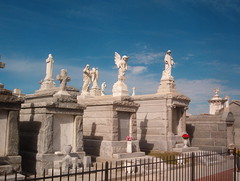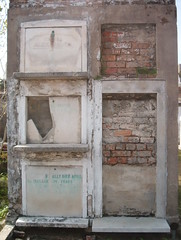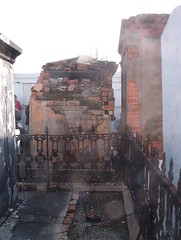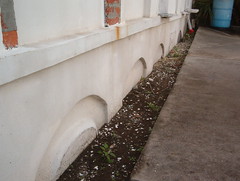While reading the Wednesday post of The Golden Road to Samarqand, Amira wrote of her love and interest in cemeteries. After reading several of the comments on that post I realized I am among friends who all have an affinity towards the history and culture of cemeteries.
Recently Thor and I were afforded the opportunity to travel to New Orleans. I had a couple of friends who had been there and also know a friend who served his mission there. Anyone I asked suggested we take a cemetery tour.
Thor wasn't available to go on tours as he was in seminars. I decided to ask a friend if she wanted go. She became very nervous about the cemetery tour but suggested we stick to the tour bus that went through the city. I will exclude the points of the tour and our guide except for the parts he explained as we went to cemetery #3 (if I am remembering correctly). The following is what I gleaned from our tour guide.
New Orleans is wet. Very wet. And due to the nature of the swamp land, humidity, and general landscape of the Delta Region provisions and laws needed to be established and are in place to this day to a certain degree. The land is saturated by all of this moisture so much so that the land itself sinks at the rate of an inch per year if not halted by man.
Back in the day, the law was set at burial needing to be done within 48 hours of the deceased finality. The body would be cleansed, dressed, and readied for the family crypt. Little or no embalming would take place. If it was used in the preparations, a special fluid was used so that the body would only be "suspended" for a minimal time. The law stated the body needed to decompose quickly. A body would be placed in a crypt for a minimum of 365 complete days.
A family would purchase cemetery land as the family plot. Calculations were made as too how much land a family could afford and how much they would need. Land was and is expensive, so a family would try to figure out just how many members could die within a certain "year" and plan accordingly within their financial means. The land being wet, an indicator of one's wealth would be the size of the crypt and how high off the ground it would rise before entry.
The larger the crypt and the higher the stairs to enter the more wealth you had. One exception was the single crypt that stated in literal stone that whoever was buried there would be there "for eternity". This was a clue to those around that the crypt would not be shared.
Shared? Yes. Let's say you have a family plot and build a crypt large enough to house four tombs. What do you do when the fifth member of the family dies? Well, you throw Auntie Prudence down the family pit and move in Uncle Cleatus. This is accomplished rather cleverly.
This photo is a great visual for the process. You can see in the photo that the crypt is built from brick. This was part of the law. Because of the plague and other diseases, bodies were required to be encased in brick, and sealed with concrete (lower right tomb) for the first 365. In this crypt there are 6 tombs, each (originally) with a facade of marble for genealogical information. As one body would complete there term the facade would be removed. This exposed the brick, which would be disassembled and exposed the casket. The caskets were made so that once the body had decayed, the ends could be removed. Auntie Prudence's remains, usually just bones, would then be pushed out of the casket via the open foot end and then would drop into the pit that was below each crypt, once there, Auntie Prudence would be taken into the earth naturally by Mother Nature over the years.
This particular crypt is in decay, most likely because the family who shares this plot have moved on to another area in the country and economics being what they are currently, they can afford to buried elsewhere.
In this photo, you can see that neglect has exposed this crypt (in the center rear) to the elements and decay has set in, almost to the point where total reconstruction will need to take place. The crypt held three tombs. What we are viewing in this photo is the back of the tomb where much of the "work" was accomplished. It is a good photo in that it shows the extra length in the crypt and the construction that allows the process to happen. You can see the roof line, then a dark rectangular piece; that dark rectangle is actually and open part of the tomb, exposing the inner area of the top tomb. Broken and tumbling bricks are falling over due to gravity and into the area built to accommodate the falling bones. Exposure to the weather has evidently filled the open spaces of this crypt with enough soil, debris, etc, that plants are now filling the space. Although, in my limited knowledge, I think this would happen rather easily if not constantly maintained as we saw many city buildings that had ferns just growing into the exterior walls - many of them several stories up. Finding a crack in a wall is all it takes for a seed to find its' new home.
Also in this photo is a great example of a family plot whose finances were meager. Saying that, I somehow think this is where my family would have been buried. Perhaps in the old south this was a poor person, maybe today it would be the lower middle class? This is a ground level crypt. It has the cement borders and the tomb on the left still has the cement casing on the top. The wrought iron fence was there to show respect, but also to keep animals and visitors from walking on the crypt in an attempt to preserve the structure. Due to the level of the tombs, more than likely the caskets would have deteriorated right along with the body and sunk into the earth at a rapid rate.
The poor were left to rent community crypts. Essentially these were made of brick and usually made as the structure that surrounded the cemetery, looking like a tall, wide and thick brick wall. The front of the community crypts were built similar to the others with a false front and labeling system for identification. These crypts could also be rented for a one year (or more if needed) period by families whose plot was filled, but not legally able to be opened and rearranged to accommodate the new dead. Let's say Auntie Prudence was buried on May 24, 1823. She took her place in the vault. One more space was available and then Uncle Cleatus died two days later on May 26, 1823. Uncle Cleatus would take the last available space. Now because all the spaces are filled the family would hope no one would die until May 25 of 1824. Knowing that Gramma Jed had died earlier that same year, January 10, 1823 his space would become available on January 11, 1824 but he cannot be disturbed for 365 days. So when Gramma Edwina died May 30, 1823 she would have no where to go except the rental crypt. She also would have to stay there for the required 365 days; so if someone dies after her, say on February 28, 1824 they could slip in the family crypt BEFORE Gramma Edwina, because the Grampa could then be removed and she take his place for free. This would leave Edwina waiting for another available tomb in the family plot, extending her stay with the "undesirables" in the city plot.
This is a photo that explains just what Nature is capable of. The arches on the bottom of the photo are actually the top of the tombs' "headstone"s, showing that this land has sunk considerably since the time of construction. The guide here told listeners that this area sank at the level of 1 inch annually. These tombs' headstones were originally at average eye level for an easy identification. Nature finds a way of recovering what is hers.
























No comments:
Post a Comment